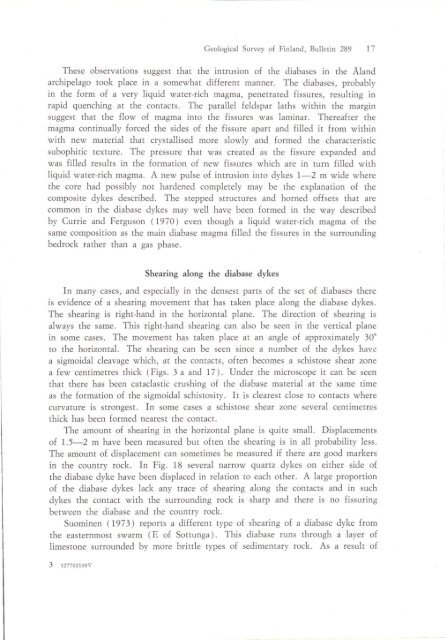Geological Survey of Finland Bulletin 289 - arkisto.gsf.fi
Geological Survey of Finland Bulletin 289 - arkisto.gsf.fi
Geological Survey of Finland Bulletin 289 - arkisto.gsf.fi
Create successful ePaper yourself
Turn your PDF publications into a flip-book with our unique Google optimized e-Paper software.
<strong>Geological</strong> <strong>Survey</strong> oE <strong>Finland</strong>, <strong>Bulletin</strong> <strong>289</strong> 17<br />
These observations suggest that the intrusion <strong>of</strong> the diabases in the Aland<br />
archipelago took place in a somewhat different manner. The diabases, probably<br />
in the form <strong>of</strong> a very liquid water-rich magma, penetrated <strong>fi</strong>ssures, resulting in<br />
rapid quenching at the contacts. The parallel feldspar laths within the margin<br />
suggest that the flow <strong>of</strong> magma into the <strong>fi</strong>ssures was laminar. Thereafter the<br />
magma continually forced the sides <strong>of</strong> the <strong>fi</strong>ssure apart and <strong>fi</strong>lled it from within<br />
with new material that crystallised more slowly and formed the characteristic<br />
subophitic texture. The pressure that was created as the <strong>fi</strong>ssure expanded and<br />
was <strong>fi</strong>lled results in the formation <strong>of</strong> new <strong>fi</strong>ssures which are in turn <strong>fi</strong>lled with<br />
liquid water-rich magma. A new pulse <strong>of</strong> intrusion into dykes 1-2 m wide where<br />
the core had possibly not hardened completely may be the explanation <strong>of</strong> the<br />
composite dykes described. The stepped structures and horned <strong>of</strong>fsets that are<br />
common in the diabase dykes may weIl have been formed in the way described<br />
by Currie and Ferguson (1970) even though a liquid water-rich magma <strong>of</strong> the<br />
same composition as the main diabase magma <strong>fi</strong>lled the <strong>fi</strong>ssures in the surrounding<br />
bedrock rather than a gas phase.<br />
Shearing a10ng the diabase dykes<br />
In many cases, and especially in the densest parts <strong>of</strong> the set <strong>of</strong> diabases there<br />
is evidence <strong>of</strong> a shearing movement that has taken place along the diabase dykes.<br />
The shearing is right-hand in the horizontal plane. The direction <strong>of</strong> shearing is<br />
always the same. This right-hand shearing can also be seen in the vertical plane<br />
in some cases. The movement has taken pI ace at an angle <strong>of</strong> approximately 30°<br />
to the horizontal. The shearing can be seen since a number <strong>of</strong> the dykes have<br />
a sigmoidal eleavage which, at the contacts, <strong>of</strong>ten becomes a schistose shear zone<br />
a few centimetres thick (Figs. 3 a and 17). Under the microscope it can be seen<br />
that there has been cataelastic crushing <strong>of</strong> the diabase material at the same time<br />
as the formation <strong>of</strong> the sigmoidal schistosity. It is elearest elose to contacts where<br />
curvature is strongest. In some cases a schistose shear zone several centimetres<br />
thick has been formed nearest the contact.<br />
The amount <strong>of</strong> shearing in the horizontal plane is quite small. Displacements<br />
<strong>of</strong> 1.5-2 m have been measured but <strong>of</strong>ten the shearing is in all probability less.<br />
The amount <strong>of</strong> displacement can sometimes be measured if there are good markers<br />
in the country rock. In Fig. 18 several narrow quartz dykes on either side <strong>of</strong><br />
the diabase dyke have been displaced in relation to each other. A large proportion<br />
<strong>of</strong> the diabase dykes lack any trace <strong>of</strong> shearing along the contacts and in such<br />
dykes the contact with the surrounding rock is sharp and there is no <strong>fi</strong>ssuring<br />
between the diabase and the country rock.<br />
Suominen (1973) reports a different type <strong>of</strong> shearing <strong>of</strong> a diabase dyke from<br />
the easternmost swarm (E <strong>of</strong> Sottunga). This diabase runs through a layer <strong>of</strong><br />
limes tone surrounded by more britde types <strong>of</strong> sedimentary rock. As a result <strong>of</strong><br />
3 127702109V

















